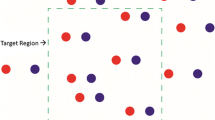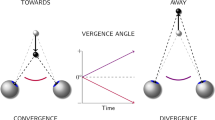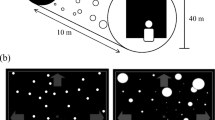Abstract
Random dots moving with various velocity gradients were presented to observers; the motion was yoked to head movement in one condition and to no head movement in another. In Experiment 1, 12 observers were shown motion gradients with sine, triangle, sawtooth, and square waveforms with amplitudes (equivalent disparities) of 12′ and 1° 53′. In Experiment 2, 48 observers were shown only the sinewave or square-wave gradient of 1° 53′ disparity either with or without head movement so that the observers’ expectation to see depth in one condition did not transfer to another. The main findings were: (1) with 12′ disparity, the head-movement condition produced perceived depth but almost no perceived motion, whereas the no-head-movement condition produced both perceived depth and perceived motion; (2) with 1° 53′ disparity, both conditions produced perceived depth and perceived motion; and (3) when the expectation to see depth was removed, the no-head-movement condition with the square-wave gradient produced no perceived depth, only motion. We suggest that monocular stereopsis with head movement can be achieved without perception of motion but monocular stereopsis without head movement requires perception of motion.
Similar content being viewed by others
References
Braunstein, M. L. (1968). Motion and texture as sources of slant information.Journal of Experimental Psychology,78, 247–253.
Braunstein, M. L. (1976).Depth perception through motion. New York: Acadenuc Press.
Braunstein, M. L., &Andersen, G. J. (1981). Velocity gradients and relative depth perception.Percepnon & Psychophysics,29, 145–155.
Braunstein, M. L., &Tittle, J. S. (1988). The observer-relative velocity field as the basis for effective motion parallax.Journal of Experimental Psychology. Human Perception & Performance,14, 582–590.
Cutting, J. E. (1986).Perception with an eye for motion. Cambridge, MA: MIT Press.
Farber, J. M., &McConkie, A. B. (1979). Optical motions as Information for unsigned depth.Journal of Experimental Psychology: Human Perception & Performance,5, 494–500.
Flock, H. R. (1964). Some conditions sufficient for accurate monocular perceptions of moving surface slants.Journal of Experimental Psychology,67, 560–572
Gibson, E. J., Gibson, J. J., Smith, O. W., &Flock, H. (1959). Motion parallax as a determinant of perceived depth.Journal of Experimental Psychology,58, 40–51.
Gibson, J. J. (1950).The perception of the visual world. Boston: Houghton Mifflin.
Graham, C. H. (1951). Visual perception In S. S. Stevens (Ed.),Handbook of experimental psychology (pp. 868–920). New York: Wiley.
Heine, L (1905). On perception and conception of distance differences.Albrecht yon Graefes Archiv für Klinische und Expertmentelle Opthamologie,61, 484–498.
Ittelson, W. H. (1960).Visual space perception New York: Springer.
Kaufman, L. (1974).Sight and mind: An introduction to visual percepnon. New York. Oxford University Press.
Koenderink, J. J. (1985). Space, form and optical deformations. In D. J. Ingle, M. Jeannerod, & D N. Lee (Eds),Brain mechanisms and spatial vision (pp 31–58). Dordrecht Martinus Nijhoff.
Lee, D. N (1974) Visual information about locomotion. In R. B MacLeod & H. L Pick, Jr (Eds.),Perception. Essays in honor of James J Gibson (pp. 250–267) Ithaca, NY Cornell University Press
Mack, A. (1986) Perceptual aspects of motion in the frontal plane. In R. K. Boff, L. Kaufman, & J. P. Thomas (Eds),Handbook of perception and human performance (pp 17–1-17-38) New York Wiley.
Mather, G (1989). Early motion processes and the kinetic depth effect.Quarterly Journal of Experimental Psychology,41A, 183–198
Ono, H., Rogers, B. J., Ohmi M., &Ono, M. E. (1988). Dynamic occlusion and motion parallax in depth perceptionPerception,17, 255–266.
Ono, M. E., Rivest, J., &Ono, H (1986) Depth perception as a function of motion parallax and absolute-distance information.Journal of Experimental Psychology,12, 331–337.
Regan, D. M. (In press) Depth from motion and motion In depth. In D. Regan (Ed.),Vision and visual dysfunction. Vol. 10A. Binocular vision. London: Macmillan.
Rogers, B. J., &Collett, T. S. (1989) The appearance of surfaces specified by motion parallax and binocular dispanty.Quarterly Journal of Experimental Psychology,41, 697–717
Rogers, B J., &Graham, M. (1979). Motion parallax as an independent cue for depth perception.Perception,9, 125–134
Rogers, B., &Graham, M. (1982). SimdanUes between motion parallax and stereopsis in human depth perception.Vision Research,22. 261–270.
Rogers, B. J., &Koenderink, J. (1986) Monocular aniseikonia A motion parallax analogue of the disparity-induced effectNature,322, 62–63.
Rogers, B. J., Ono, H., &Rogers, S (1988). The role of visual and non-visual information in disambiguating motion parallax transformations.Investigative Ophthalmology & Visual Science,29(Suppl 3), 265
Saida, S., & Ono, H. (1989).What extent of motion parallax produces depth perception? Abstract submitted for presentation
Sedgwick, H A. (1986). Space perception. In R. K. Boff, L. Kaufman, & J P. Thomas (Eds.),Handbook of perception and human performance (pp. 21–1-21-57). New York: Wiley.
Steinbach, M. J., Ono, H., & Wolf, M. E. (In press). Motion parallax judgements of depth as a function of the direction and type of head movement.Canadian Journal of Psychology.
Swanston, M. T., &Wade, N. J. (1987). The perception of visual motion during movements of the eyes and of the headPerception & Psychophysics,43, 559–566
Swanston, M. T., Wade, N. J., &Day, R D (1987). The representation of uniform motion in vision.Perception,16, 143–159.
Wallach, H. (1985). Perceiving a stable environmentScientific Amencan,252, 118–124.
Author information
Authors and Affiliations
Additional information
This research was supported by Grants A0296 and A7664 from the Natural Sciences and Engineering Research Council of Canada, and by Grant EY05960 from the Nauonal Insututes of Health.
Rights and permissions
About this article
Cite this article
Ono, H., Steinbach, M.J. Monocular without stereopsis with and head movement. Perception & Psychophysics 48, 179–187 (1990). https://doi.org/10.3758/BF03207085
Received:
Accepted:
Published:
Issue Date:
DOI: https://doi.org/10.3758/BF03207085




